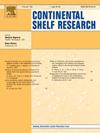Seasonal variability of the Pearl River Plume front based on deep learning
IF 2.2
3区 地球科学
Q2 OCEANOGRAPHY
引用次数: 0
Abstract
Ocean fronts are characterized by active vertical shear and mixing, which play a role in primary production, fishery resources, and marine ecosystems. While oceanographers have focused on the dynamics and biogeochemical processes of the Pearl River Plume, the seasonal variations of the plume front remain unclear. In this study, we investigate the seasonal and interannual variations in front intensity within and around the Pearl River Estuary by extracting remote sensing turbidity gradient images using the BOA algorithm. We then apply a deep learning technique to these turbidity gradient images to detect river plume fronts. The deep learning network successfully identifies two types of Pearl River Plume fronts: one with clear and distinct features, and the other displaying diffuse and fragmented characteristics. We further map the seasonal dispersal patterns of the Pearl River Plume front probability, revealing westward and eastward distributions of plume fronts in summer, and a more frequent westward distribution in autumn and winter. A front hotspot is observed near the western coast off the Pearl River Estuary, where the strength of front probability is influenced by the magnitude of the northeasterly wind.
基于深度学习的珠江羽锋季节变化
海锋以活跃的垂直切变和混合为特征,在初级生产、渔业资源和海洋生态系统中发挥着重要作用。虽然海洋学家一直关注珠江羽流的动力学和生物地球化学过程,但羽流锋面的季节性变化仍不清楚。本研究利用BOA算法提取珠江口及其周边地区的遥感浊度梯度图像,研究锋面强度的季节和年际变化。然后,我们对这些浊度梯度图像应用深度学习技术来检测河流羽流前缘。深度学习网络成功识别出两种类型的珠江羽锋,一种特征清晰鲜明,另一种特征分散碎片化。进一步绘制了珠江羽流锋面概率的季节分布格局,揭示了夏季羽流锋面向西和向东分布,秋冬季羽流锋面向西分布更为频繁。珠江口西岸附近有一个锋面热点,锋面概率的强弱受东北风强度的影响。
本文章由计算机程序翻译,如有差异,请以英文原文为准。
求助全文
约1分钟内获得全文
求助全文
来源期刊

Continental Shelf Research
地学-海洋学
CiteScore
4.30
自引率
4.30%
发文量
136
审稿时长
6.1 months
期刊介绍:
Continental Shelf Research publishes articles dealing with the biological, chemical, geological and physical oceanography of the shallow marine environment, from coastal and estuarine waters out to the shelf break. The continental shelf is a critical environment within the land-ocean continuum, and many processes, functions and problems in the continental shelf are driven by terrestrial inputs transported through the rivers and estuaries to the coastal and continental shelf areas. Manuscripts that deal with these topics must make a clear link to the continental shelf. Examples of research areas include:
Physical sedimentology and geomorphology
Geochemistry of the coastal ocean (inorganic and organic)
Marine environment and anthropogenic effects
Interaction of physical dynamics with natural and manmade shoreline features
Benthic, phytoplankton and zooplankton ecology
Coastal water and sediment quality, and ecosystem health
Benthic-pelagic coupling (physical and biogeochemical)
Interactions between physical dynamics (waves, currents, mixing, etc.) and biogeochemical cycles
Estuarine, coastal and shelf sea modelling and process studies.
 求助内容:
求助内容: 应助结果提醒方式:
应助结果提醒方式:


